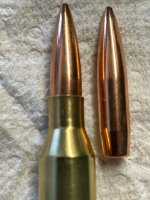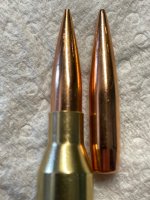So what is the donut, how does it get there and what effect does it have on loading and load performance?? I suspect I have donuts in my Lapua case neck as I'm getting signs of pressure in a gas gun when there should be none. Due to some pressure signs of swipe and ejector marks in what I would have thought to be fairly average moderate loads, I just re-ran a load test basically a full grain less and I'm still getting swipe.
The reason I suspect the "donut" is because when you slide a bullet into a fired neck, it feels like it hits a stop right around the shoulder/neck junction and my shooting partner said "It feels like a donut".
The lighter load where I'm still getting pressure and swipe is in a .260 gasser, 22" JP barrel w/ headspaced High pressure bolt, Lapua 3x fired brass, 41.9 gr of H4350 with 130 Berger Hybrids (2792 fps). The other load is 123 scenars @ 42.4 H4350 (2870 fps) that I'm getting even more pressure and swipe with.
Any thoughts would be appreciated. TIA
The reason I suspect the "donut" is because when you slide a bullet into a fired neck, it feels like it hits a stop right around the shoulder/neck junction and my shooting partner said "It feels like a donut".
The lighter load where I'm still getting pressure and swipe is in a .260 gasser, 22" JP barrel w/ headspaced High pressure bolt, Lapua 3x fired brass, 41.9 gr of H4350 with 130 Berger Hybrids (2792 fps). The other load is 123 scenars @ 42.4 H4350 (2870 fps) that I'm getting even more pressure and swipe with.
Any thoughts would be appreciated. TIA


